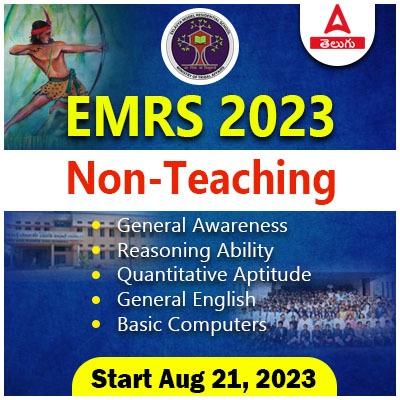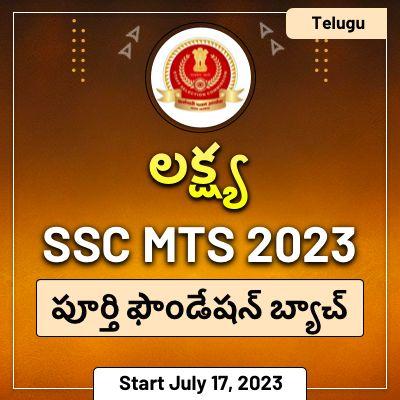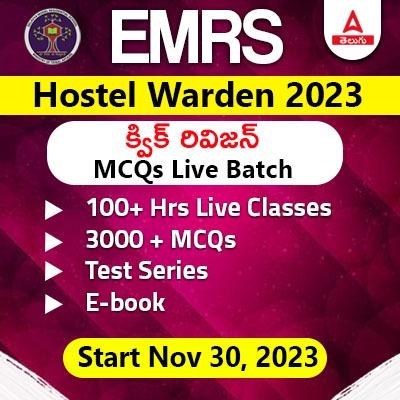
ఆంధ్రప్రదేశ్ మరియు తెలంగాణ లో అత్యంత ముఖ్యమైన మరియు ప్రతిష్టాత్మకమైన పరీక్షలు గ్రూప్-1,2,3 అలాగే UPSC లలోనికి చాలా మంది ఆశావహులు ఈ ప్రతిష్టాత్మక ఉద్యోగాల్లో కి ప్రవేశించడానికి ఆసక్తి చూపుతారు.దీనికి పోటీ ఎక్కువగా ఉండడం కారణంగా, అధిక వెయిటేజీ సంబంధిత సబ్జెక్టులను ఎంచుకుని స్మార్ట్ అధ్యయనంతో ఉద్యోగం పొందవచ్చు. ఈ పరీక్షలలో ముఖ్యమైన అంశాలు అయిన పౌర శాస్త్రం , చరిత్ర , భూగోళశాస్త్రం, ఆర్ధిక శాస్త్రం, సైన్సు మరియు విజ్ఞానం, సమకాలీన అంశాలు చాల ముఖ్యమైన పాత్ర పోషిస్తాయి. కాబట్టి Adda247, ఈ అంశాలకి సంబంధించిన కొన్ని ముఖ్యమైన ప్రశ్నలను మీకు ప్రతిరోజు క్విజ్ రూపంలో అందిస్తుంది. ఈ పరీక్షలపై ఆసక్తి ఉన్న అభ్యర్థులు దిగువ ఉన్న ప్రశ్నలను పరిశీలించండి.
ప్రశ్నలు
Q1. ‘లోటస్ మహల్’, ‘మహానవమి దిబ్బ’ నిర్మించడం ఏ రాజ్యంలో ఒక ముఖ్యమైన లక్షణం
(a) విజయనగర
(b) చండేలా
(c) పల
(d) రాష్ట్రకూట
Q2. రాష్ట్రకూటులకు సంబంధించిన దిగువ ప్రకటనలను పరిగణనలోకి తీసుకోండి:
- గ్రామ పెద్ద, గ్రామ అకౌంటెంట్ ల పదవులు సాధారణంగా వంశపారంపర్యంగా వచ్చేవి.
- భూస్వామ్య పరిపాలన పూర్తిగా రద్దు చేయబడింది.
పైన ఇవ్వబడ్డ ప్రకటనల్లో ఏది సరైనది?
(a) 1 మాత్రమే
(b) 2 మాత్రమే
(c) 1 మరియు 2 రెండూ
(d) 1,2 కాదు
Q3. అలవుద్దీన్ ఖిల్జీకి సంబంధించిన ఈ క్రింది ప్రకటనలను పరిగణనలోకి తీసుకోండి
- భూమి శిస్తు అంచనా కోసం భూమిని కొలిచే శాస్త్రీయ పద్ధతిని అలవుద్దీన్ ఖిల్జీ ప్రవేశపెట్టాడు.
- సర్దార్లకు, జాగీదార్లకు, ఉలేమాకు పన్నులను రద్దు చేశాడు.
పైన ఇవ్వబడ్డ ప్రకటనల్లో ఏది సరైనది?
(a) 1 మాత్రమే
(b) 2 మాత్రమే
(c) 1 మరియు 2 రెండూ
(d) 1,2 కాదు
Q4. ఈ క్రింది వారిలో ఎవరిని ప్రసిద్ధ “కర్ణాటక సంగీత త్రయము”గా వర్ణిస్తారు?
(a) పంపా, పొన్న మరియు రానా
(b) త్యాగరాజ, ముత్తుస్వామి మరియు శ్యామశాస్త్రి.
(c) నన్నాయ, తిక్కన మరియు ఏరన్న
(d) సంబందనార్, సుందరర్, అప్పర్
Q5. నందుల యొక్క పాలనకు సంబంధించి దిగువ ప్రకటనలను పరిగణనలోకి తీసుకోండి:
- వారి పాలనలో అలెగ్జాండర్ వాయువ్య భారతదేశంపై దాడి చేశాడు.
- చంద్రగుప్త మౌర్యడు మౌర్య పాలనను స్థాపించడానికి ధనానందను ఓడించాడు.
పైన ఇవ్వబడ్డ ప్రకటనల్లో ఏది సరైనది?
(a) 1 మాత్రమే
(b) 2 మాత్రమే
(c) 1 మరియు 2 రెండూ
(d) 1,2 కాదు
Q6. ఈ క్రింది వాటిలో మౌర్య సామ్రాజ్యాన్ని వర్ణించిన విదేశీ యాత్రికుడు ఎవరు?
- ఫా హియెన్
- హియుయెన్ త్సాంగ్
- ప్లినీ
- మెగస్తనీస్
దిగువ నుంచి సరైన కోడ్ ఎంచుకోండి:
(a) 1, 2 మరియు 3
(b) 1 మరియు 4
(c) 2, 3 మరియు 4
(d) 1, 2, 3 మరియు 4
Q7. ఈ క్రింది వాటిలో ఎవరు మౌర్య సామ్రాజ్యం యొక్క అశ్వికదళాన్ని వివరించే “సహజ చరిత్ర” అనే పుస్తకాన్ని వ్రాశారు?
(a) ప్లినీ
(b) మెగస్తనీస్
(c) అల్ బ్రానీ
(d) ఇబ్న్ బటుటా
Q8. హరప్పా నాగరికతకు సంబంధించిన ఈ క్రింది ప్రకటనలను పరిగణనలోకి తీసుకోండి:
- డబ్బు ఉపయోగించకుండా వస్తువుల మార్పిడి పై వాణిజ్యం ఆధారపడి ఉండేది.
- హరప్పన్లకు సముద్రం గురించి జ్ఞానం లేదు.
పైన ఇవ్వబడ్డ ప్రకటనల్లో ఏది సరైనది?
(a) 1 మాత్రమే
(b) 2 మాత్రమే
(c) 1 మరియు 2 రెండూ
(d) 1,2 కాదు
Q9. దిగువ ప్రకటనలను పరిగణనలోకి తీసుకోండి.
- చైనా యాత్రికుడు ఫా-హీన్ సముద్రగుప్తుడి ఆస్థానాన్ని సందర్శించాడు
- సముద్రగుప్తుడు ‘విక్రమాదిత్య’ అనే ప్రసిద్ధ బిరుదును స్వీకరించాడు.
పైన ఇవ్వబడ్డ ప్రకటనల్లో ఏది సరైనది?
(a) 1 మాత్రమే
(b) 2 మాత్రమే
(c) 1 మరియు 2 రెండూ
(d) 1,2 కాదు
Q10. కవి హరీసెన ఈ క్రింది రాజులలో ఏ రాజును “కవిరాజా” అని వర్ణించాడు.
(a) సముద్ర గుప్తా
(b) చంద్రగుప్తా -I
(c) చంద్రగుప్తా – II
(d) పైన పేర్కొన్నవేవీ కావు
ఆన్లైన్ లైవ్ క్లాసుల కొరకు ఇక్కడ క్లిక్ చేయండి
జవాబులు
S1.Ans.(a)
Sol.One of the most beautiful buildings in the royal center of Vijayanagara Kingdom is the Lotus Mahal, so named by British travelers in the nineteenth century. While the name is certainly romantic, historians are not quite sure what the building was used for. It is also called the Kamal Mahal or Chitragani Mahal. The curves of the palace are given an Islamic touch while the multi-layered roof design is moreover related to the Indo style of buildings. It is designed as a palace for royal ladies of those times to mingle around and enjoy recreational activities. The Mahal also served as a meeting point for the king and his ministers.
S2.Ans.(a)
Sol.The Rashtrakuta Empire was divided into several provinces called rashtras under the control of rashtrapatis. They were further divided into vishayas or districts governed by vishayapatis. The next subdivision was bhukti consisting of 50 to 70 villages under the control of bhogapatis. These officers were directly appointed by the central government.
Statement 1 is correct: The village administration was carried on by the village headmen and village accountants whose posts were generally hereditary. However, the village assemblies played a significant role in the village administration. They were paid by grants of rent-free lands.
Statement 2 is not correct: The rise of hereditary elements led to village communities and committees becoming weaker. The central ruler also found it difficult to assert his authority over them and control them. This is what led to the feudalism of government.
S3.Ans.(a)
Sol.Some of the reforms introduced by him were:
- Alauddin Khilji maintained a strong and huge standing army to safeguard his empire.
- He introduced the system of branding of horses (dagh) and maintenance of the descriptive register of soldiers to prevent false musters and corrupt practices.
- Alauddin abolished the Jagir system and paid the salaries in cash to soldiers.
- He fixed the pay of soldiers at 234 tankas a year, with an additional 78 tankas for a soldier maintaining two horses.
- Ariz-i-Mumalik was in charge of the appointment of soldiers.
- Alauddin Khilji introduced the scientific method of measurement of land for the assessment of land revenue. He was the first sultan to realize land revenue after the assessment of land and measurement of land under cultivation. The post of a special officer called “Mustakhraj” was created to collect land revenue from peasants in doab area and khalisa lands.
- The sultan deprived the Khuts, Maqaddams, and Chaudhuris of their privileges. They were forced to pay land revenue and other peasants were taxed. Khuts were large landowners and Muqaddams were village headmen. They were given the task to collect taxes in iqta lands and often given the privilege to not pay any land revenue by the earlier sultans. He took steps to safeguard the peasants from the demands of corrupt revenue officials by imposing strict punishments even for petty offenses.
- He imposed heavy taxes on the Sardars, Jagidars, and Ulemas.
S4.Ans.(b)
Sol.The birth of the Carnatic Musical Trinity – Tyagaraja, Muthuswami Dikshitar, and Syama Sastri – at Tiruvarur between the years 1750 to 1850 A.D. ushered in an era of dynamic development in Carnatic music. The Trinity was not only contemporaries among themselves but, also contemporaries of great composers of Western Music.
- Pampa, Ponna, and Rana are known as the “three gems of ancient Kannada literature”.
- Nannaya, Thikkana, and Eranna are famously known as ” Kavitrayam ” which means trinity of poets. These poets translated the great epic Mahabharata into Telugu.
- Sundarar, Sambandar, Appar three most prominent Tamil poets of the 7th and 8th centuries whose works constitute Thevaram, the first seven volumes of Tirumurai a Śaiva devotional poetry.
- Hence, option (b) is the correct answer.
S5.Ans.(c)
Sol.Dhana Nanda :
- He was the last Nanda ruler.
- He is referred to as Agrammes or Xandrames in Greek texts.
- Alexander invaded North-Western India during his reign; but he could not proceed towards the Gangetic plains because of his army’s refusal. Hence, statement 1 is correct.
- He inherited a huge empire from his father. According to Pliny, a Roman writer, he possessed a standing army of 200,000 infantry, 20,000 cavalries, 3000 elephants, and 2000 chariots. He became a powerful ruler because of this.
- He is said to be one of the 8 or 9 sons of Mahapadma Nanda.
- He became unpopular with his subjects owing to an oppressive way of extorting taxes. Also, his Sudra origins and an anti-Kshatriya policy led to a large number of enemies.
- Finally, he was overthrown by Chandragupta Maurya along with Chanakya, which led to the foundations of the Maurya Empire in Magadha. Hence, statement 2 is correct.
S6.Ans.(d)
Sol.Foreign Sources
- Megasthenes, who has been sent as an ambassador by Seleucus Nicator to the court of King Chandragupta Maurya, gave in his book “Indica” (written in Greek) some controversial points saying that (i) There was no slavery in India, (ii) No famines were there in India, (iii) He divides the Indian society into 7 castes, altogether mentioning new castes and (iv) Usury (lending money with higher interest rate) was absent in India.
- Pliny, who belonged to 1st Century AD and a native of Rome, in his book “Natural History” (written in 72 AD), mentioned the military strength of the Mauryan empire.
Pliny said that the Mauryan army had 6 lakh infantry, 30 thousand cavalries, 9000 elephantry, and 8000 chariotry. These are the 4 wings of the army, known as Chaturangabala.
- Sri Lankan Buddhist texts (written in Pali) Mahavamsa, Culavamsa. Dipavamsa and Vamsathapakasini talk about the history Mauryan dynasty.
- Travel accounts of 3 Chinese travelers give information about the Mauryan empire. Fa Hien visited India when Chandragupta II was the king. Hiuen Tsang was in India when Harshavardhana was the king. I-Tsing, who resided at Nalanda monastery for ten years, was in India between 673 AD and 685 AD.)
S7.Ans.(a)
Sol.Pliny, who belonged to 1st Century AD and a native of Rome, in his book “Natural History” (written in 72 AD), mentioned the military strength of the Mauryan empire.
Pliny said that the Mauryan army had 6 lakh infantry, 30 thousand cavalries, 9000 elephantry, and 8000 chariotry. These are 4 wings of the army, known as Chaturangabala
S8.Ans.(a)
Sol.The Indus Valley Civilisation (IVC) was a Bronze Age civilization in the northwestern regions of South Asia, lasting from 3300 BCE to 1300 BCE, and in its mature form from 2600 BCE to 1900 BCE. The Harappans carried on a considerable trade in stone, metal, shell, etc., within the Indus culture zone.
- However, the cities did not possess basic raw materials for the commodities they produced. In return for finished goods and possibly food grains, they procured metals from the neighboring areas by boats and bullock carts.
- Metal money was not used and trade was carried by barter system. Hence statement 1 is correct.
- The Harappan people used to trade with foreign lands traveling through seas. They practiced navigation on the coast of the Arabian Sea. The Harappan seal that was recovered from excavation indicates a mast & sailboat while the Mohenjo-Daro seal & a terracotta amulet show a ship with cabins & birds. Dockyard and Clay’s model boats were found from excavations at Lothal which was the port city of the Harappan period. Hence statement 2 is not correct.
S9.Ans.(d)
Sol.Chandragupta-II: The reign of Chandragupta II saw the high watermark of the Gupta empire.
- The greatest of the military achievements of Chandragupta II was his war against the Saka ruler Rudrasimha-III and this victory gave him the title “Sakari” – the destroyer of sakas.
- He also took the title of Vikramaditya. Hence, statement 2 is not correct.
- The exploits of a king called Chandra are glorified in an iron pillar inscription fixed near Qutb Minar in Delhi. If Chandra is considered to be identical with Chandragupta II, it appears that he established Gupta authority in north-western India and in a good portion of Bengal.
- The famous Chinese pilgrim and traveler, Fa-Hien visited India during the reign of Chandragupta-II. Hence, statement 1 is not correct.
S10.Ans.(a)
Sol.Samudragupta (reign 335-380 AD) was the son of Chandragupta –I and Kumaradevi
Harisena composed the Allahabad pillar Inscription or Prayag Prasasti. The Pillar was an Asokan Pillar erected by Asoka six centuries before him.
This Inscription is a eulogy of Samudragupta and mentions the conquests of Samudragupta and the boundaries of the Gupta Empire. As per this inscription, Samudragupta defeated 9 kings in the North, 12 Kings in the South, reduced all the Atavika states to vassalage. It also mentions that more than five states in the frontier states surrendered and accepted his suzerainty. He had close contact with the kingdom of Ceylon and Southeast Asian colonies. The eulogy of Harisena describes him as the hero of 100 battles. He performed Ashvamedha Yajna, this has been testified by a seal of Samudragupta bearing a Horse. This was probably the first Ashvamedha after Pushyamitra Shunga.
He is depicted in his coins playing Veena. He allowed the king of Ceylon to build a monastery at Bodhgaya.
Another term used by Harisena for him is Kaviraja, which testified him as a patron of poetic arts and a poet himself.
ఆన్లైన్ లైవ్ క్లాసుల కొరకు ఇక్కడ క్లిక్ చేయండి
ఆంధ్ర ప్రదేశ్ జాగ్రఫీ మరియు వీక్లీ కరెంటు అఫైర్స్ డౌన్లోడ్ చేసుకొనుటకు ఇక్కడ క్లిక్ చేయండి
9 & 10 May 2021 యొక్క కరెంటు అఫైర్స్ కొరకు ఇక్కడ క్లిక్ చేయండి
9 & 10 మే 2021 యొక్క కరెంటు అఫైర్స్ క్విజ్ కొరకు ఇక్కడ క్లిక్ చేయండి












